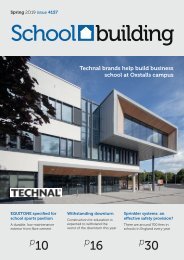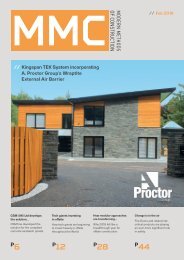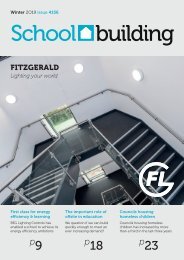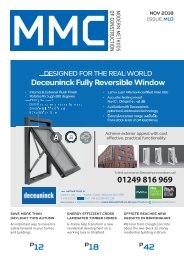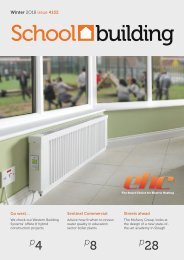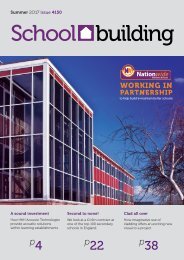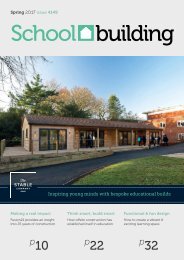R&R 8954 52 Nov '15 cc
You also want an ePaper? Increase the reach of your titles
YUMPU automatically turns print PDFs into web optimized ePapers that Google loves.
All-encompassing educational design<br />
| Article<br />
A student with Special educational needs (SEN) has a disability or communication challenges that makes it harder for them to learn<br />
than others of the same age. There can be several issues obstructing their progress – the learning environment being one of the main<br />
contributing factors. Here, Shane Cryer of Ecophon discusses the role of acoustics in the SEN learning environment.<br />
The addition of low frequency absorption may<br />
be fitted into dry lined walls, but in a<br />
refurbishment project this is not always practical.<br />
A cost effective solution is Ecophon’s Extra Bass<br />
pads, placed on top of the suspended ceiling, out<br />
of sight, allowing the capture of the disruptive<br />
low frequencies before they spread back into the<br />
classroom.<br />
To ensure the su<strong>cc</strong>ess of the project when<br />
possible acoustic consultants who are<br />
experienced in this type of design should be<br />
involved early on, as acoustic modelling may be<br />
required to ensure the very best design is<br />
created.<br />
The SEN provision is an important introduction<br />
to this sector and one that Ecophon has<br />
welcomed. Schools and parents need to really<br />
Around one in five children will be diagnosed<br />
with a special educational need at some point<br />
during their school years. SEN students often<br />
need additional support and can be challenging<br />
to teach. In 2013 - 2014 the DfE reported that<br />
4000 secondary school students were<br />
permanently excluded from school, of these<br />
70% fell into the SEN category.<br />
Educational establishments can help most<br />
children and young people overcome the barriers<br />
that SEN can present with extra help for some, or<br />
all, of their education years. Much of this help is<br />
based on one-on-one support, yet perhaps an<br />
area that is often overlooked is the difference<br />
the overall environment can have on learning –<br />
with acoustics a key determinant.<br />
Thanks to a number of Building Bulletins, the<br />
importance of good acoustic design in schools<br />
has achieved increasing recognition. In fact, it’s<br />
gone from merely guidance (BB51) to being<br />
mandatory, thanks to regulations such as Building<br />
Regulations, School Premises Regulations,<br />
Independent Schools Standard and the Equality<br />
Act 2010.<br />
Since 2003, BB93 ‘Acoustic Design for Schools’ has<br />
been used to determine compliance with these<br />
regulations. In addition, Part E of the Building<br />
Regulations states: ‘the normal way of satisfying<br />
requirement E4 will be to meet the values given<br />
in section 1 of BB93.’<br />
In 2014, BB93 was revised and subsequently reissued<br />
in 2015. This revision supports provisions of<br />
the Equality Act 2010, which requires all schools<br />
to prepare and implement an a<strong>cc</strong>essibility<br />
strategy to improve the physical environment of<br />
a school for pupils with disabilities and special<br />
educational needs (SEN). Now, the bulletin<br />
provides for a wider range of SEN and is perhaps<br />
the bulletin’s most significant development.<br />
For this new standard, the reverberation time in<br />
an SEN teaching space must be at 0.4 seconds or<br />
below, over a wide frequency range, 125Hz –<br />
4000Hz something that educational<br />
establishments need to be aware of.<br />
Ecophon recognises the importance of<br />
educational design in relation to SEN and has<br />
undertaken considerable research and<br />
development. As such, the company has<br />
identified a number of areas to consider in terms<br />
of acoustic design to meet the new standard.<br />
Ideally, SEN children should be taught in smaller<br />
classes – the bigger the room volume the more<br />
the reverberation, so keeping the room size<br />
down and in particular the ceiling height to no<br />
more than 2.4m high, will make a real difference.<br />
In terms of absorptive finishes, only ‘Class A’<br />
should be used since these are the most efficient.<br />
However, to meet the SEN standard, controlling<br />
low-frequency (bass) sound with additional low<br />
frequency absorption is necessary. In fact, this is<br />
key because these frequencies have the ability to<br />
pass through masonry walls, which means they<br />
can also pass through traditional suspended<br />
ceilings and bounce back into the room. This low<br />
frequency sound is particularly disruptive to<br />
hearing impaired, autistic and ADHD students.<br />
understand the risks of poor acoustics,<br />
particularly for SEN students, by considering this<br />
new guidance and understanding the simplest<br />
way to comply. Retrospectively treating a<br />
classroom to meet the new standard can be<br />
achieved simply and cost-effectively by working<br />
with products such as those offered by Ecophon.<br />
For more information on Ecophon,<br />
visit www.ecophon.com/uk<br />
<strong>Nov</strong>ember2O15 issue <strong>8954</strong> refurb| RENEW 21



